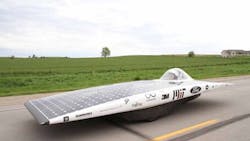Solar Electric Car Helps to Bring Technology Closer to Commercialization
A new solar electric car called Arcturus will race in the Bridgestone World Solar Challenge, Australia, in October. The car, sponsored by UPS and The MIT Center for Transportation & Logistics, was designed and built by a team of students at the Massachusetts Institute of Technology.
Arcturus, which weighs 490 pounds, uses solar energy to charge a battery. It consumes the same amount of energy as a hand-held hairdryer to sustain speeds of more than 60 mph.
To achieve this performance, the team has minimized the weight of the car while still complying with safety regulations. The chassis is constructed of chromoly steel tubing, an alloy commonly used in race vehicle applications owing to its higher strength-to-weight ratio compared to standard steel tubing.
"UPS supports a wide variety of education and alternative fuel programs," said Randy Stashick, president of engineering for UPS. "MIT's solar electric vehicle team is doing some incredible work researching how solar energy can become a mainstream power source for passenger and commercial vehicles. It's critical that the business community support programs that combine science and technology research that have practical research outcomes."
The vehicle's footprint is comparable to a standard passenger vehicle, enabling the team to transfer knowledge to production passenger and commercial vehicle designs. The team believes that advances in manufacturing processes, such as 3-D printing of composite materials, could greatly accelerate the mass production of solar vehicles.
The Australian Outback is one of the world's premier events for promoting the development of solar powered vehicles. Each Challenge moves solar car design closer to commercialization
"The solar challenge tests more than design,” said Rose Abramson, captain for the MIT Solar Electric Vehicle Team. It tests robustness and reliability, which is so important to transferring what we do to a conventional vehicle.
The project has inspired spin-off products related to solar power applications and lithium battery systems that are used in various industries including military and agriculture, and could be applied to commercial vehicles. One near-term application of the car's solar-power technology in the supply chain management field could be to power in-vehicle equipment such as refrigeration units.
"Solar-powered commercial vehicles might seem like a long way off, but the MIT Team's pioneering work to create Arcturus brings us a step closer to this goal," said Professor Yossi Sheffi, Director of MIT CTL.
